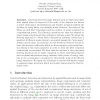Free Online Productivity Tools
i2Speak
i2Symbol
i2OCR
iTex2Img
iWeb2Print
iWeb2Shot
i2Type
iPdf2Split
iPdf2Merge
i2Bopomofo
i2Arabic
i2Style
i2Image
i2PDF
iLatex2Rtf
Sci2ools
117
Voted
ECCV
2004
Springer
2004
Springer
Steering in Scale Space to Optimally Detect Image Structures
Detecting low-level image features such as edges and ridges with spatial filters is improved if the scale of the features are known a priori. Scale-space representations and wavelet pyramids address the problem by using filters over multiple scales. However, the scales of the filters are still fixed beforehand and the number of scales is limited by computational power. The filtering operations are thus not adapted to detect image structures at their optimal or intrinsic scales. We adopt the steering approach to obtain filter responses at arbitrary scales from a small set of filters at scales chosen to accurately sample the "scale space" within a given range. In particular, we use the Moore-Penrose inverse to learn the steering coefficients, which we then regress by polynomial function fitting to the scale parameter in order to steer the filter responses continuously across scales. We show that the extrema of the polynomial steering functions can be easily computed to detect i...
Arbitrary Scales | Computer Vision | ECCV 2004 | Image Structures | Intrinsic Scales | Multiple Scales | Polynomial Steering Functions |
Related Content
| Added | 15 Oct 2009 |
| Updated | 15 Oct 2009 |
| Type | Conference |
| Year | 2004 |
| Where | ECCV |
| Authors | Jeffrey Ng, Anil A. Bharath |
Comments (0)

